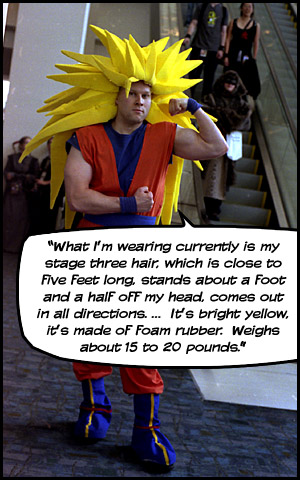
photo by Courtney Reid-Eaton
Japan: Big in America
We went to the Mid-Atlantic Anime Convention in June at the Greater Richmond Convention Center in Richmond, Virginia. Now, I've never been to a Trekkie convention, but that's how I imagine it. It seemed like that kind of scene.
It was a summer weekend day and the hall was filled with young fans. Very diverse crowd. There was a room with video games, then there was another section of the convention center where you could buy all kinds of merchandise. Then there were three rooms where you had anime films running.
"This is our biggest crowd we've ever had," says Edward L. Fortner, Jr., chairman and CEO for the convention. "I think we're somewhere around, approaching 3,000 right now. In 2001 we had 617 people. So, quite a bit of growth over the last couple years. There were 135 conventions last year in the US."
Did you get that? 135 conventions last year. That's two conventions a week, on average, somewhere in the United States. And we're talking everywhere. Norman, Oklahoma. Cedar Rapids, Iowa. And the biggest, which is in Anaheim, California, 40,000 fans in the summer of 2006.
"There is this Japanese air or flair that certainly is popular. It's big. It is really, really big," says Anne Allison, professor of cultural anthropology at Duke University.
She has a new book out about the global spread of Japanese stuff for kids. The book is called Millennial Monsters. She's been watching the trend since the early 90s. That's when it really took off. In Japan, the 1990s is called the lost decade. But exports of Japanese pop culture tripled.
And a really interesting thing happened culturally. Anne Allison talks about the first Japanese TV show to really make it big in the US and much of the world. You remember, Mighty Morphin Power Rangers. It hit the U.S. on Fox Kids in 1993.
"When it was being considered for broadcast in the U.S.," says Allison, "it took the guy who had the property, Haim Saban, eight years to get a network interested because they thought - first of all, they thought it was stupid. They thought American kids were too sophisticated to appreciate anything as dumb as that. Totally wrong. But they also thought American kids would not be enticed by the Asianness."
So in the scenes where you could see the faces of the characters, they'd be re-shot with American, mostly-Caucasian actors. They "de-Japanized" the show. But now if you turn on the kids' channels on cable, there are a whole bunch of shows that are boldly Japanese.
"All of these things have overt signs of coming from a place that's not the U.S.," says Allison. "You see temples, you see shrines, you see Japanese script. People are eating with chopsticks, they're eating rice, they're drinking tea. … Now, that is what sells. Now you have U.S.-produced television shows that are set in Japan. And they're produced in the U.S. … Because Japan, or Asia, or this kind of vague place over there, is enticing to kids, it signifies cool. And that's a huge change."
![]()

